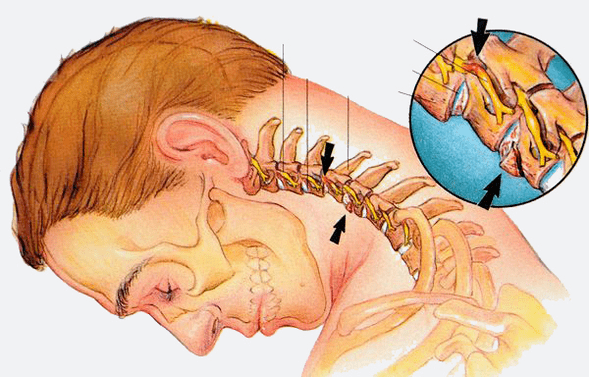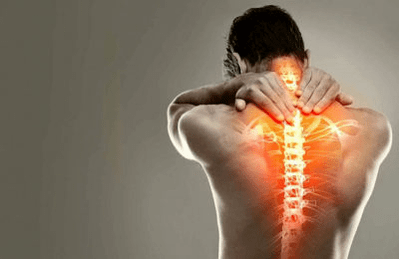Many people deal with the lack of physical activity today.Monotonous office work, a long stay on TV at home, as well as improper food - these are the main causes of many diseases.One of them can be called osteochondrosis of the cervical region, one of the most mobile segments of the human spine.It is on it that a large amount of loads are every day, because its main function is to keep your head.
This disease brings considerable discomfort in patients' lives and is just as common in both women and men.The disease is considered progressive, associated with degenerative-district disorders of the intervertebral discs and therefore requires timely treatment for qualified medical care.
The reasons for developing pathology

Osteochondrosis can affect all departments, but given the increase in cervical region activity, it often develops in it.
The disease is conditionally divided into 4 main stages:
- The first is associated with initial disorders of the vertebral discs, which is associated with unstable features, and the symptoms are slightly pronounced.
- The second - in which the gaps between the vertebrae are reduced and the destruction of the fiber ring begins, it is possible to violate the nerve roots and, as a result, the pain.
- Third - when the ring destruction is already in the last stage, intervertebral hernias can form and often there are signs of spinal deformity.
- The fourth is the most severe phase when bone growth occurs and every movement becomes very painful and almost impossible, which in the absence of treatment can cause disability.
Currently, there is an important discovery of osteochondrosis in young people, including the cervical region.If this disease was previously considered age-related and found in patients aged 40, today young people aged 18-30 are often encountered with this problem.
The causes of the disease are the following:

- overweight problems;
- violation of the behavior and bending of the spine;
- Delayed metabolic processes in the body;
- different spine trauma;
- heavy physical work and systematic growth of considerable weights;
- Class of some sports, violation of the training process;
- In particular, poor physical physical training, weakness of back muscle lanes;
- systemic hypothermia;
- Trans transferred infectious diseases;
- Reduce lifestyle, lack of physical exercise.
The reasons for limiting the mobility of the cervical region are also typical.These are muscle cramps, worsening blood supply, squeezing nerve endings, narrowing of holes between vertebrae, and developing dystrophic processes in vertebrae and intervertebral discs.
Symptoms of the disease
Characteristic symptoms and signs of cervical osteochondrosis are largely the result of a violation of blood supply to the head and brain.This is due to the fact that the cervical region is saturated with blood vessels and it is thanks to them that the human brain is powered.
The characteristic symptoms of cervical department pathology are as follows:
- headache, which, depending on the degree of the disease, can be quite severe and systemic;
- Dizziness for cervical osteochondrosis is often associated with a loss of consciousness;
- the presence of a characteristic sound in the ear, often a loss in hearing;
- violation of coordination of movements, walking;
- vision of vision;
- elevated skin temperature, and sometimes a total elevated body temperature;
- Sound changes, for example, freezing sound or noisy presence;
- unsatisfactory teeth condition;
- a feeling of numbness of the fingers, cooling and feeling of hand weakness;
- neck pain, throat, pain in contact with scalp, sometimes even toothache;
- The pain that spreads to the hand, the shoulders and its strengthening with different curves or movement of the neck and head;
- Nausea or even vomiting that can accompany severe pain.
Headache, restriction of mobility and other symptoms can be present in both complexes and separately, and have a different degree of intensity.As a rule, it depends directly on which specific object is affected by the disease.On this basis, the disease is classified into so -called radicular syndromes, vertebral artery syndrome, compression of the spinal cord, radical syndrome, reflex syndromes and others.
Treatment of cervical back osteochondrosis
If the treatment of cervical spine osteochondrosis is absent, then patients may suffer typical symptoms of an untreated disease (headache, memory deterioration, fever, dizziness, etc.) and then encounter very unpleasant consequences.For example, this may be a violation of cerebral circulation that occurs due to the deterioration of blood flow through the vessels.

To avoid this, a patient who noticed the first signs of pathology, it is necessary to seek qualified help.
To provide first aid to the patient, you can use soothing soothing and anti -inflammatory medicines (tablets, ointments, injections).You can also apply distinctive medicines, for example, by warming ointments with snake poison in or based on bee venom before visiting a doctor before visiting a doctor.When edema is formed, diuretics should be used or swelling with folk remedies, for example, decoction of plants.As for a doctor's visit, he must be mandatory, regardless of the relief of the patient during self -medication.
We do not cure prolonged osteochondrosis of the cervix.
Cervical spine osteochondrosis, as a rule, is diagnosed on the basis of patient complaints.To confirm the diagnosis, methods such as radiological examination, CT or MRI are used.
After confirmation of the diagnosis, the specialist describes the treatment depending on the stage of the disease, the individual characteristics of the patient's health as a whole.It is worth noting that you can get rid of the problem with the help of medicine only in its early stages.In the treatment of pathology at the beginning of its development, treatment with folk remedies can be quite effective.
As for the most advanced stages of cervical osteochondrosis, their treatment decreases to a decrease in the discomfort, pain and physical suffering of patients.With a competent and integrated approach, it is possible to eliminate the main symptoms of the disease and prevent potential irritations, as well as suspend the development of pathological processes in the spine.
Comprehensive treatment of the disease involves the use of traditional medicines and non -traditional methods.Also, at the pardon phase, additional treatment with popular remedies is permissible.
Among the most common methods of treatment of the disease, the following can be noted:

- vacuum therapy;
- treatment with medication;
- acupuncture;
- Laser therapy;
- electrical stimulation;
- dry traction;
- Magnet treatment;
- The therapeutic gymnastics class;
- Course of therapeutic massage, etc.
To remove the pain syndrome, as a rule, it is enough for the patient to pass 1-3 treatment sessions.To consolidate positive therapeutic success, about 10-15 therapeutic sessions can be required.After removing the acute phase, they turn to the therapeutic gymnastics and massage.This will help restore blood circulation and strengthen muscles.























